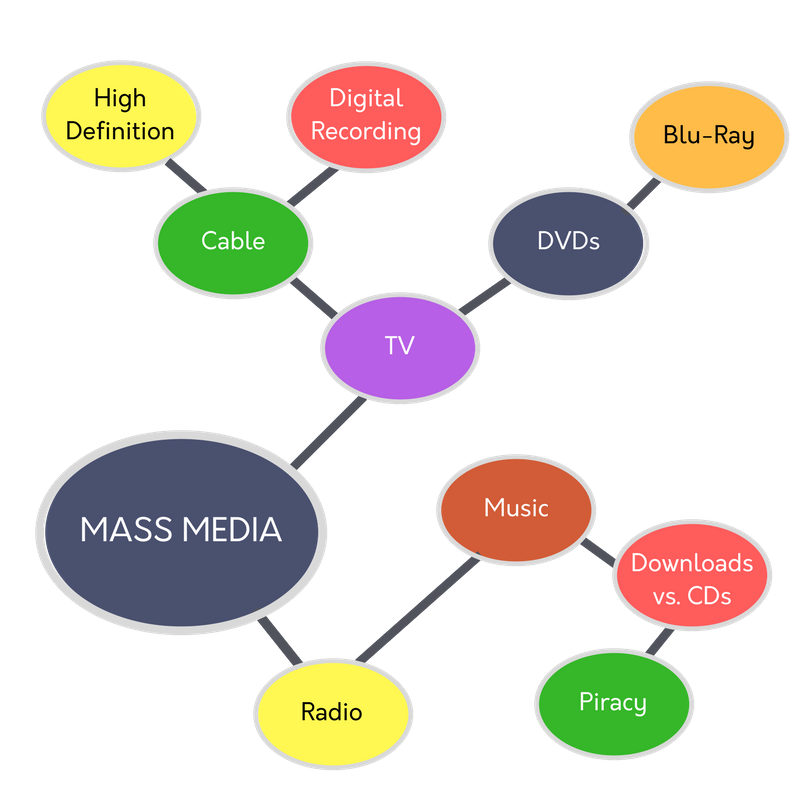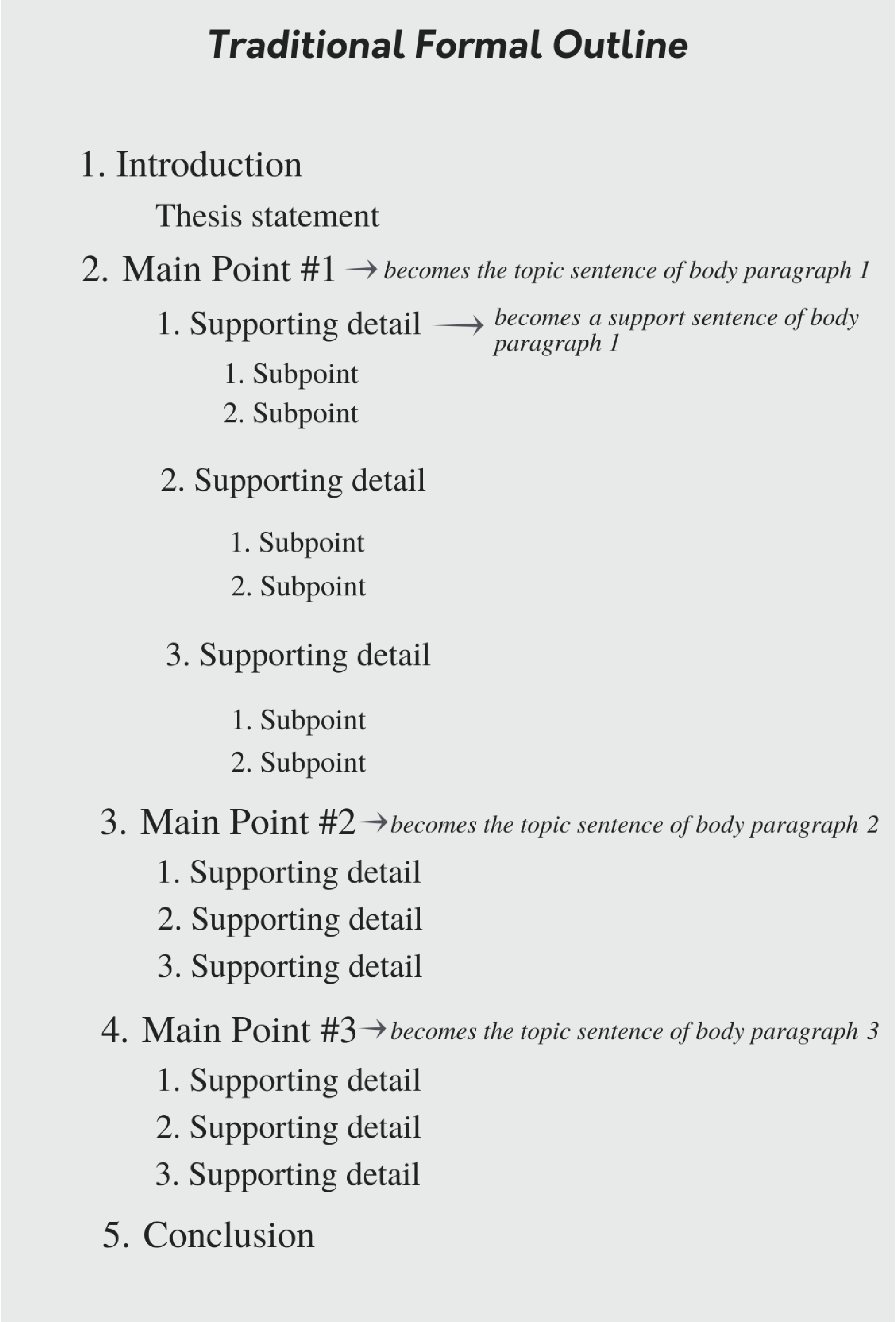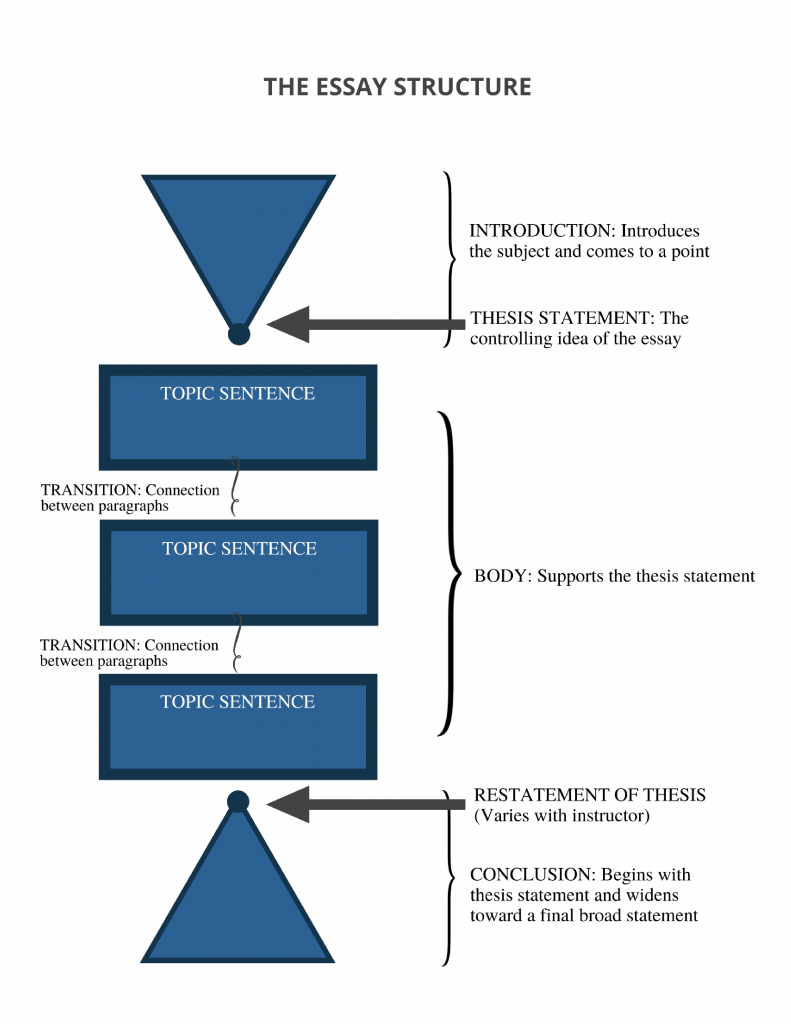24 How to organize and arrange?
Kathy Boylan
Once you have generated supporting ideas for the main idea of your paper, you need to arrange those ideas in some type of order. Clustering and outlining can help organize the ideas.
Clustering (also called idea mapping) is a way of visually arranging ideas. Begin clustering by writing the topic in the center of a sheet of paper. Circle the topic, and then surround it with words and phrases that identify the major points to be discussed in the paper. Continue the process until all supporting details and secondary details have been listed. Many writers like this method because the shapes show how the ideas relate or connect, and writers can find a focused topic from the connections mapped. Using clustering, you might discover connections between topics that you had not thought of before.
Figure 4.2 Clustering

Outlining lists the major supporting details in a tentative order and includes secondary supporting details.
Figure 4.3 Traditional Formal Outline

Before you write, you need to decide how to organize your ideas. You need to determine the rhetorical mode(s) that will be used and the order of the supporting ideas. Simplistically speaking, there are nine basic rhetorical modes. They are as follows: narration, description, exemplification, process, cause and effect, comparison and contrast, classification and division, definition, and argument. However, most complex writing begins with an argument of some sort and then uses a combination of modes to relay one’s message.
Structure of a Paragraph and Essay
All formal paragraphs and essays have a title, a beginning or an introduction, a middle-a body of supporting paragraphs, and an end or conclusion.
A title is at the top of your paragraph or essay, but it is often the last thing that you create because until the paper is complete, you do not really know what your final product will be. A good title makes people want to read your paper; it does not merely repeat the topic sentence or thesis statement; it hints at your main idea. It is not a complete sentence, but it is a phrase or phrases that indicate your topic.
An effective introduction captures your readers’ attention and arouses their curiosity. In a paragraph, it is often your topic sentence, and in an essay, it usually includes your thesis statement, which narrows your subject, claims something specific and significant, and conveys your purpose and often your form of organization. You can include a question, tell a story, use a quotation, give interesting facts or statistics, give background information, or outline a problem and/or a solution. Do not tell the reader what your topic is–show them. Do not be vague and mysterious. Do not refer back to your title. Do not apologize for what you are about to say, and be original. The important thing is that you hook your readers’ attention and motivate them to continue reading.
Your body of supporting evidence should be organized, unified and coherent. The support can be organized using chronological order, spatial order, or emphatic order. Each supporting detail should have its own topic sentence and be developed with valuable supporting details. In an essay, the supporting ideas should support your thesis statement. You should use transitional words or phrases to establish connections between paragraphs and different ideas. You should use parallel structure throughout your paper and use repetition sparingly and only when it is effective and necessary. Be consistent in tense, number, and person throughout your paper as well. The entire body of supporting evidence should be focused on supporting your main idea without straying off topic or including unrelated ideas.
Your conclusion should let the readers know that you are finished and not leave them with any unanswered questions. It may recommend a call to action, or it may just summarize a long and complex paper. The conclusion may repeat some of the ideas from the introduction, but it should not be a replica of that paragraph. It may restate your main idea. The conclusion can be either hopeful or hopeless depending on the mood of your paper. You may leave your reader with some final important facts, or a compelling example, or a final visual image. It is important that you do not go off in a new direction in your conclusion. Do not make sweeping generalizations, and again do not apologize for any of your ideas. Once these arrangements and ideas have been decided, then an outline should be constructed.
Figure 4.4 The Essay Structure

Using a Clear Organizational Pattern
Depending on your topic, you might find it beneficial to use one of these common organizational patterns, either within individual paragraphs or within the entire essay:
|
Pattern |
Explanation |
Example |
|
Process analysis |
A process analysis paragraph is used to describe how something is made or to explain the steps for how something is done. |
The first key to growing good tomatoes is to give the seedlings plenty of room. Make sure to transplant them to small pots once they get their first leaves. Even when they are just starting out in pots, they need plenty of light, air, and heat. Make sure to warm the ground in advance by covering it in plastic sheeting for a couple of weeks. When you are ready to plant them in soil, plant them deeply enough, so they can put down some strong roots. Mulch next, and once the stems of the tomato plants have reached a few inches in height, cut off the lower leaves to avoid fungi. Carefully prune the suckers that develop in the joints of the developing stems. |
|
Chronological |
Chronological arrangement presents information in time order. |
As soon as I arrived at the farmers’ market, I bought a large bag of lettuce. I walked around the corner and saw the biggest, most gorgeous sunflower I had ever seen. I bought it and added it to my lettuce bag. The flower was so big that I had to hold the bag right in front of me to keep it from being bumped. At the Wilson Pork Farm booth, I tasted a little pulled pork. You guessed it—I had to buy a quart of it. I went on with a plastic quart container in my left hand and my lettuce and flower in my right hand. I was handling it all just fine until I saw a huge hanging spider plant I had to have. Ever so gently, I placed my pulled pork container inside the spider fern plant pot. Now I was holding everything right in front of me as I tried to safely make my way through the crowd. That is when I met up with little Willie. Willie was about seven years old, and he was playing tag with his brother. I am not sure where their mother was, but Willie came running around the corner and smacked right into me. You are probably thinking that poor Willie had pulled pork all over his clothes and an upside-down plant on his head, but no, not at all. I was the one. Willie didn’t even notice. He was too busy chasing his brother. |
|
General-to-specific |
A common paragraph format is to present a general idea and then give examples. |
The displays at the farmers’ market do not lack for variety. You will see every almost every kind of fresh, locally grown food you can imagine. The featured fruits on a given day might be as varied as pomegranates, persimmons, guava, jackfruit, and citron. Vegetables might include shiitake mushrooms, artichokes, avocados, and garlic. Some vendors also sell crafts, preserves, seeds, and other supplies suitable for starting your own garden. |
|
Specific-to-general |
The reverse of the above format is to give some examples and then summarize them with a general idea. |
Your sense of smell is awakened by eighteen varieties of fresh roma tomatoes. Your mouth waters at the prospect of sampling the fresh breads. Your eye catches a glimpse of the colors of handmade, embroidered bags. You linger to touch a perfectly ripe peach. Your ears catch the strain of an impromptu jug band. A walk up and down the aisles of your local farmers’ market will engage all of your senses. |
|
Spatial |
A paragraph using spatial organization presents details as you would naturally encounter them, such as from top to bottom or from the inside to the outside. In other words, details are presented based on their physical location. |
From top to bottom, the spice booth at our farmers’ market is amazing. Up high vendors display artwork painstakingly made with spices. At eye level, you see at least ten different fresh spices in small baggies. On the tabletop is located an assortment of tasting bowls with choices ranging from desserts to drinks to salads. Below the table, but out of the way of customers, are large bags of the different spices. Besides being a great use of space, the spice booth looks both professional and charming. |

